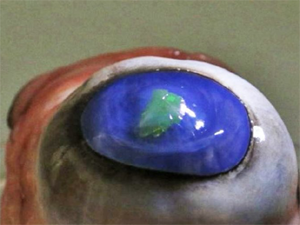



Date:03/05/18
 Researchers have developed an ultrathin and flexible membrane, less than a thousandth of a millimeter thick, that can be placed onto a contact lens, enabling the wearer to essentially shoot lasers from their eyes.
Researchers have developed an ultrathin and flexible membrane, less than a thousandth of a millimeter thick, that can be placed onto a contact lens, enabling the wearer to essentially shoot lasers from their eyes.
The membrane, which was developed by scientists from the University of St Andrews in Scotland, is made from an organic semiconducting polymer—a broad class of materials that consist of many repeated chains of molecular units. It emits very low-powered laser light when illuminated by another laser.
Each membrane is able to produce a unique "barcode"—a well-defined series of laser beams in the form of sharp lines. This could have applications in identification technology as a kind of wearable security tag, according to the researchers.
The membrane—which is one of the world’s smallest and lightest lasers—could also be applied to other objects, such as polymer banknotes, in which it could act as an authentication feature to protect against counterfeiting. It even has the potential to be used as a sensor to detect explosives.
In a study published in the journal Nature Communications, the researchers described the new membrane and demonstrated its laser producing capabilities by attaching it to a contact lens and placing it on the eyeball of a cow— which are often used as an analogue for the human eye. The team's results showed that it would be safe to use in humans.
“In ancient Greece, Plato believed that visual perception is mediated by ‘eye beams’—beams actively sent out by the eyes to probe the environment,” Malte Gather, a physics professor from the School of Physics and Astronomy at St Andrews, said in a statement.
“Plato’s emission theory has of course long been refuted, but superheroes with lasers in their eyes live on in popular culture and comic books. Our work represents a new milestone in laser development and, in particular, points the way to how lasers can be used in inherently soft and ductile environments, be it in wearable sensors or as an authentication feature on bank notes,” he added.
New Contact Lens Could Let You Shoot Lasers From Your Eyes
 Researchers have developed an ultrathin and flexible membrane, less than a thousandth of a millimeter thick, that can be placed onto a contact lens, enabling the wearer to essentially shoot lasers from their eyes.
Researchers have developed an ultrathin and flexible membrane, less than a thousandth of a millimeter thick, that can be placed onto a contact lens, enabling the wearer to essentially shoot lasers from their eyes.The membrane, which was developed by scientists from the University of St Andrews in Scotland, is made from an organic semiconducting polymer—a broad class of materials that consist of many repeated chains of molecular units. It emits very low-powered laser light when illuminated by another laser.
Each membrane is able to produce a unique "barcode"—a well-defined series of laser beams in the form of sharp lines. This could have applications in identification technology as a kind of wearable security tag, according to the researchers.
The membrane—which is one of the world’s smallest and lightest lasers—could also be applied to other objects, such as polymer banknotes, in which it could act as an authentication feature to protect against counterfeiting. It even has the potential to be used as a sensor to detect explosives.
In a study published in the journal Nature Communications, the researchers described the new membrane and demonstrated its laser producing capabilities by attaching it to a contact lens and placing it on the eyeball of a cow— which are often used as an analogue for the human eye. The team's results showed that it would be safe to use in humans.
“In ancient Greece, Plato believed that visual perception is mediated by ‘eye beams’—beams actively sent out by the eyes to probe the environment,” Malte Gather, a physics professor from the School of Physics and Astronomy at St Andrews, said in a statement.
“Plato’s emission theory has of course long been refuted, but superheroes with lasers in their eyes live on in popular culture and comic books. Our work represents a new milestone in laser development and, in particular, points the way to how lasers can be used in inherently soft and ductile environments, be it in wearable sensors or as an authentication feature on bank notes,” he added.
Views: 516
©ictnews.az. All rights reserved.Similar news
- The mobile sector continues its lead
- Facebook counted 600 million active users
- Cell phone testing laboratory is planned to be built in Azerbaijan
- Tablets and riders outfitted quickly with 3G/4G modems
- The number of digital TV channels will double to 24 units
- Tax proposal in China gets massive online feedback
- Malaysia to implement biometric system at all entry points
- Korea to build Green Technology Centre
- Cisco Poised to Help China Keep an Eye on Its Citizens
- 3G speed in Azerbaijan is higher than in UK
- Government of Canada Announces Investment in Green Innovation for Canada
- Electric cars in Azerbaijan
- Dominican Republic Govt Issues Cashless Benefits
- Spain raises €1.65bn from spectrum auction
- Camden Council boosts mobile security





















